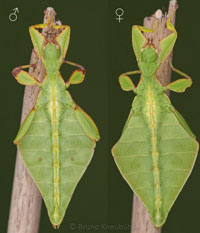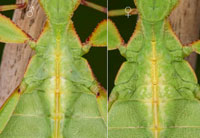At times it would be of great help to be able to distinguish between male and female nymphs - for different reasons. For example if we wanna reduce the number of nymphs (to avoid overpopulation), yet we wanna make sure that there is an equal number of males and females. Or we realize that there are just very few males or females, and wanna take special care of them in a seperate cage - to make sure that the culture does not become parthenogenetic.
Luckily this is possible, and actually not difficult. On the morphological level, the primary sexual characteristics are already presend even at the first nymphal stage (L1) just after hatching. And for a number of species it is easy to recognize these differences in L1, even to the naked eye. This is especially true for big and bulky species (like Phryganistria, Achrioptera, Haaniella).
In other groups (like Necrosciinae) it is somewhat difficult to see these differences in L1, unless one has a microscope at hand. For such species we wait until L3 or even L4, by then these difference between male and female nymphs become apparent.
Below you find informations on how to distinguish male and female nymphs for a number ofdifferent species:
- Achrioptera fallax "Orangea"
- Anchiale sp. "Buru"
- Autolyca sp. "Tegucigalpa, red"
- Epidares nolimetangere
- Eurycnema versirubra "Timor"
- Heteropteryx dilatata
- Phryganistria bachmaensis "Bach Ma"
- Phryganistria sp. "Da Krong"
- Phyllium celebicum "Sulawesi"
- Phyllium giganteum "Tapah"
- Phyllium letiranti "Tataba"
- Phyllium rubrum "Tapah"
Achrioptera fallax "Orangea"
The differences are easily recognizable in the 1st instar (commonly called L1):
- the developing poculum of male nymphs is easily recognizable ventrally on the 9th abdominal segment as a small "hump"
- female nymphs lack this "hump", yet with a good magnifying glass the developing gonapophyses and subgenital plate are visible ventrally on the 8th abdominal segment
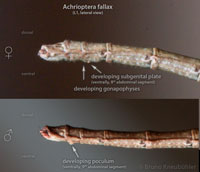
And in the 3rd instar stage (L3), this differences are even more pronounced:
- the developing poculum of male nymphs is now quite a big and obvious "hump"
- the developing subgenital plate of female nymphs already reaches to the middle of the 10th abdominal segment
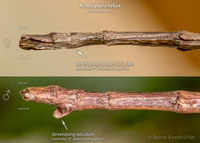
Anchiale sp. "Buru"
The differences are easily recognizable in the 3rd instar (L3):
- The developing poculum of male nymphs is visible ventrally on the 9th abdominal segment as a small "hump"
- Female nymphs lack this "hump", yet with a good magnifying glass the developing gonapophyses and subgenital plate are visible ventrally on the 8th / 9th abdominal segment
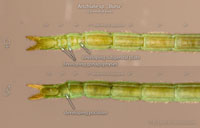
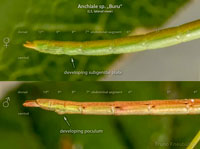
Autolyca herculeana "Tegucigalpa, red"
The differences are easily recognizable in the 1st instar (L1):
- the developing poculum of male nymphs is visible ventrally on the 9th abdominal segment as a small "hump"
- female nymphs lack this "hump", yet with a good magnifying glass the developing gonapophyses and subgenital plate are visible ventrally on the 8th / 9th abdominal segment
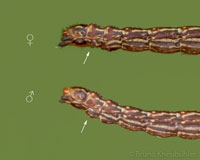
Epidares nolimetangere
The differences are easily recognizable in the 1st instar (L1). Male nymphs have a small hump (which is the developing poculum) at the ventral side of the 9th abdominal segment, whilst the female nymphs lack this hump on the 9th abdominal segment.
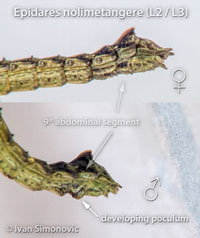
Eurycnema versirubra "Timor"
The differences are also easily recognizable in the 1st instar (L1). Male nymphs have a small hump (which is the developing poculum) at the ventral side of the 9th abdominal segment, whilst the females lack this hump on the 9th abdominal segment.
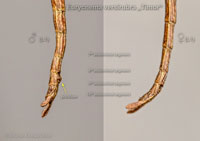
Heteropteryx dilatata
The differences are easily recognizable in the 2nd instar (L2):
- the developing poculum of male nymphs is very distinct ventrally on the 8th abdominal segment
- female nymphs have a much longer supraanal plate (dorsally, end of abdomen)
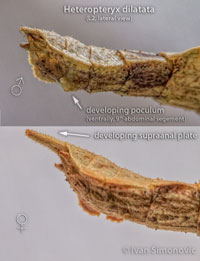
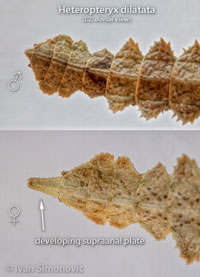
Phryganistria bachmaensis "Bach Ma"
The differences are easily recognizable in the 3rd instar (L3):
- the developing poculum of male nymphs is visible ventrally on the 9th abdominal segment as a small "hump"
- female nymphs lack this "hump", but with a good magnifying glass the developing gonapophyses and subgenital plate are visible ventrally on the 8th / 9th abdominal segment
- these differences are also visible in L1, though less obviously (see Phryganistria sp. "Da Krong")
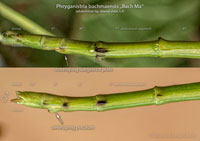
- furthemore, female nymphs in L3 have dark colored lobes on the sides of the 7. abdominal segment. These lobes are almost absent in male nymphs
- and male nymphs in L3 have long, well developed lobes at the end of the 10th abdominal segment ("latero-posterior lobes")
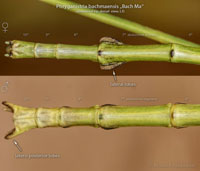
Phryganistria sp. "Da Krong"
The differences are easily recognizable in the 1st instar (L1):
- The developing poculum of male nymphs is visible ventrally on the 9th abdominal segment as a small "hump"
- Female nymphs lack this "hump", but with a good magnifying glass the developing gonapophyses and subgenital plate are visible ventrally on the 8th / 9th abdominal segment
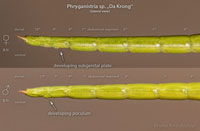
Phyllium celebicum "Sulawesi"
The differences are easily recognizable in the 3rd instar (L3):
- the 7th abdominal segment's outer border is distinctly wider in female nymphs than in male nymphs
- males nymphs abdomen is more pointed, while the female nymph's abdomen appears rather angular
- with a magnifiying glass it is easily visible that male nymphs have a small hump (the developing poculum) at the ventral side of the 9th abdominal segment. And female nymphs have a developing subgenital plate and gonapophyses ventrally on the 8th abdominal segment
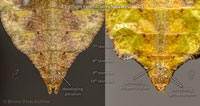
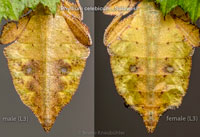
Phyllium giganteum "Tapah"
Ventral abdominal ending of female (left) and male (right) nymph in L2.
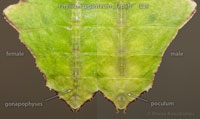
Ventral abdominal ending of female (left) and male (right) nymph - developing primary sexual characteristics (gonapoyphyses, poculum) are already visible (at least with a good magnifying glass)
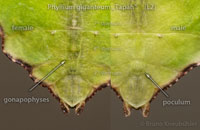
Wing buds for female (left) and male (right) nymphs in L2 - the difference in this secondary sexual characteristic is easy to see with a magnifying glass
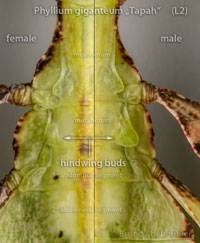
Female (left) and male (right) nymph in L2. Males have even at this early stage a slightly bell-shaped abdomen. But be cautious, as some female L2 nymphs have quite a similar shape of the abdomen. Therefore this characteristic is to be taken with a grain of salt
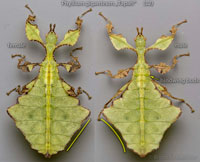
Female (left) and male (right) nymph in L3 - with details of the wings buds. At this stage, males nymphs can easily be distinguised from female nymphs by their already much bigger hind wing buds (which is a secondary sexual characteristic).
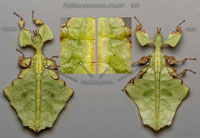
Female (left) and male (right) nymph in L4 - with details of the wings buds. At this stage, the hindwing buds of male nymphs are already quite big and easily recognisable. At this stage, nymphs of both sexes are still about the same size.
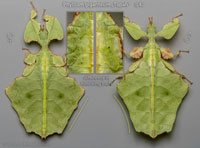
Female (left) and male (right) nymph in L4 - with details of the primary sexual characteristics (abdominal ending, ventrally). The developing gonapophyses of female nymphs (ventrally on the 8th and 9th abdominal segment) are easily visible with a good magnifying glass. On the other hand, the ventral side of the 9th abdominal segment of male nymphs is fully covered by the developing poculum.
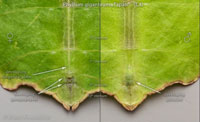
Phyllium letiranti "Tataba"
The differences are easily recognizable in the 3th instar (L3). In L3, the male's abdominal shape is a bit more pointy, and the male's hind wingbuds are much larger
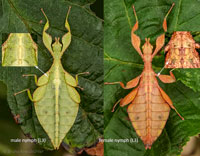
Phyllium rubrum "Tapah"
The differences are easily recognizable in the 4th instar (L4). In L4, the male's abdominal shape is a bit more pointy, and the male's hind wingbuds are much larger
